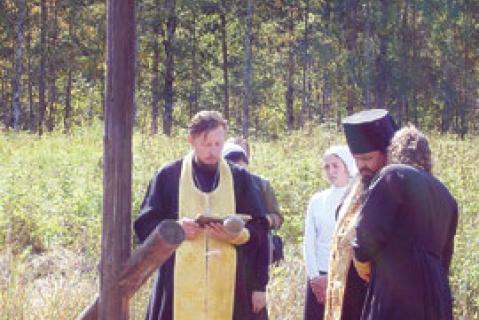In 1930 thousands of families of dekulakised Siberian peasants were forcibly resettled in the Kulai clearing among the Vasyugan marshes. They were deported as “second-category” kulaks in response to the secret 1 January 1930 resolution of the Communist Party Politburo.
The first group to arrive in March 1930 numbered 8,891, according to the documents of the Kulai commandant’s office: the office then was responsible for 22 settlements. Mortality among the settlers was high during the 1930s and they were buried in the forest near to the settlement to which they were attached. The numbers of men, women and children buried there have not been established; name lists are not available. The regime limiting the settlers’ movements was lifted in 1947 and after the last inhabitants left the settlement in the 1960s the cemetery was abandoned.
The first commemorative sign in Nizhny Kulai was put up in August 1990 by a youth expedition from Omsk: a simple board fixed to a tree, it read “To the innocent victims of Stalinist repression”. In 2000, an archaeological team found traces of settlements and crosses in the graveyards and made a topographic map of the area. In August 2004, during a pilgrimage organised by the Omsk-Tara Diocese, Father Anatoly (Ledenev) from the village of Vassis in the Tara district discovered a churchyard in woodland with five surviving crosses. Three bore barely distinguishable inscriptions: those buried in the cemetery had died between 1939 and 1964. In August 2008 Father Anatoly erected a commemorative cross there.
In all 17 volumes of Remembrance have so far been issued in the Omsk Region.
11 appeared in alphabetical sequence as Victims of Political Repression in the Omsk Region (2000-2004); they include biographical entries for 30,857 individuals. Five volumes provide biographical entries on 15,000 families in Peasant Golgotha: the Repression of the Peasantry in the Omsk Region (2013-2015). Involuntary Siberians: Deportees to the Omsk Region (2017) is the latest volume in the series.
Drawing on those and other sources, Memorial’s database (2025) names 68,706 victims in the Omsk Region (BR 46,795). See Omsk cemetery.
The “Peasant Golgotha” source names 15,657 individuals who were deported with their families from the Region – 10,308 in 1930-1 alone. Police records list more families and individuals (total 21,910) who were either sent to special settlements in the Omsk Region (over 12,000 in 1941: including 5,021 from the Saratov Region and 6,432 from the Volga German republic) or who were born there in the 1940s and 1950s (2,436).
| State of burials | Area | Boundaries |
|---|---|---|
|
have not survived
|
not determined
|
not delineated
|
[ Original texts & hyperlinks ]
I.V. Cherkasyanova, “Documents of the Kulai commandant’s office”, Omsk conference, marking the city’s 275th anniversary, Omsk, 1991
S.A. Krasilnikov, The Sickle and the Monster: Peasant exile in West Siberia during the 1930s, Moscow, 2009 (334 pp)
M.A. Sbitneva (ed.), The Peasant Golgotha: A book in remembrance of the Omsk Region’s repressed peasantry, two volumes, Omsk, 2013 (528 & 330 pp)
*
“Nizhny Kulai special settlement cemetery”, Virtual Museum of the Gulag [retrieved, 28 May 2022; no longer accessible]
Reply from the Tara urban district administration (№ 14/ТRS-421 of 08 April 2014) to a formal enquiry by RIC Memorial (St Petersburg)

